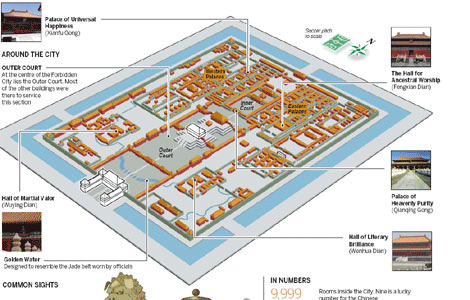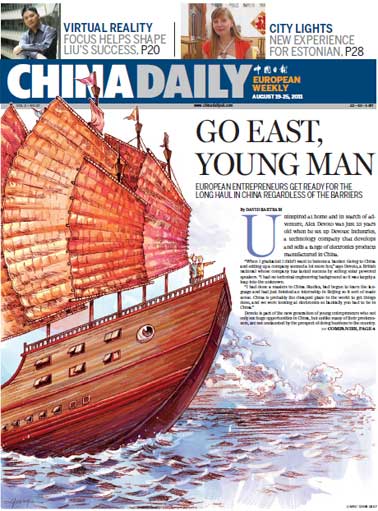Panda-ing to a global audience
Updated: 2011-03-11 10:46
By Huang Ying (China Daily European Weekly)
|
|
To all intents and purposes it looked like a real giant panda, but it was behaving in a very human fashion.
The delightful animal was filmed on a street in Chengdu, in Southwest China's Sichuan province, watching beautiful women looking in the mirror in a shopping mall, enjoying a show with other tea lovers in a teahouse and cheering along with audiences in a large stadium.
The video, Where Pandas Live. Chengdu, Real China, was first released in December, and has been broadcast by US Cable News Network (CNN).
Of course it is not a real panda but an actor wearing a high-quality costume made by the Japanese props team that worked on the Hollywood blockbuster Spider-Man.
This video was tailored for the tastes of foreigners, a move by the local government to build the city's image abroad.
Most people from overseas know more about pandas than they do about the capital of the province in which the black-and-white bears are found.
"Pandas have very high recognition abroad because they have been used frequently as the symbol of the city in many international economic and cultural exchanges," Huang Lin, Chengdu's publicity official, says.
Pandas can also make people relate to the common global issue of environmental protection, which is significant for Chengdu's marketing campaign, Huang adds. The panda is also the image used by the Worldwide Fund for Nature (known as the World Wildlife Fund in the United States).
Watching the video created feelings of homesickness for some Chengdu expatriates. Some foreign audiences, although familiar with Beijing and Shanghai, expressed surprise at the beauty of Chengdu.
The city advertising video is just one part of a diverse marketing campaign that was launched in the wake of the Wenchuan earthquake in Sichuan province on May 12, 2008. An estimated 68,000 people perished in the disaster that also caused great economic loss.
"We established a partnership with the Chengdu municipal government after 2008, providing professional advice and strategies for its city branding," says Zhou Xiaojun, vice-president of public affairs at Ogilvy Public Relations Worldwide.
The advertising campaign consists of various elements launched in different phases, Zhou says.
"That Chengdu remains safe and beautiful is the principal message we want to convey to the public shortly after the earthquake," he says, adding that the post-disaster reconstruction creates a great opportunity for the city's development.
What happened in subsequent years proved Zhou was right about the potential for economic growth.
In 2008, Chengdu's GDP was 390.1 billion yuan (43 billion euros) with a year-on-year growth of 12.1 percent, its lowest since 2003. The figure rose to 550.83 billion yuan in 2010, ranking it fourth among China's provincial capitals.
Because of the reconstruction and city marketing campaigns, Chengdu gradually evolved from a domestically high-profile city to the one receiving worldwide recognition.
The World Centre of Excellence for Destinations dubbed Chengdu as one of the world's excellent destinations for visiting in 2009, making it the first city to receive the title in Asia.
The panda's hometown was also given the green light by the United Nations Educational, Scientific and Cultural Organization (UNESCO) to become one of the organization's Cities of Gastronomy in March 2010.
The city topped the list of the next decade's fastest-growing cities in a Forbes Magazine prediction published on Oct 7, 2010.
In addition to its growing global reputation, Chengdu's fast rebound from the catastrophe also attract investment from both domestic and multinational companies, including US computer makers Dell Inc and Intel Corp, DHL Express, Amazon and A.P. Moller-Maersk Group.
Damco, the Denmark-based freight forwarding arm of A.P. Moller-Maersk Group, one of the world's top logistics companies, opened its new customer service center in Chengdu in March 2010, after the establishment of Maersk Global Service Centers in the same city in October 2009. Damco is one of the world's largest logistics and supply chain management companies.
Last year, Chengdu Panda Research Base launched its Project Panda - a global search for a Chengdu "pambassador", in partnership with the Worldwide Fund for Nature. Six pambassadors from five countries, including Sweden, Japan and France, were chosen from 12 finalists.
"Involving general public in a marketing campaign usually generates much better results because it grabs their attention directly," Zhou says.
E-paper

Unveiling hidden treasures
The Forbidden City, after the Great Wall, is the most recognized tourist site in China.
Short and sweet
Game for growth
Character reference
Specials

China at her fingertips
Veteran US-China relations expert says bilateral ties have withstood the test of time

The myth buster
An outsider's look at china's leaders is updated and expanded

China in vogue
How Country captured the fascination of the world's most powerful fashion player

